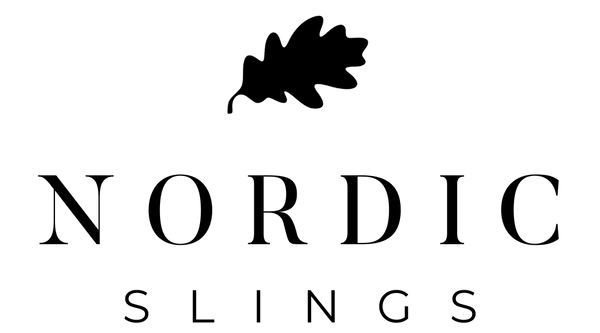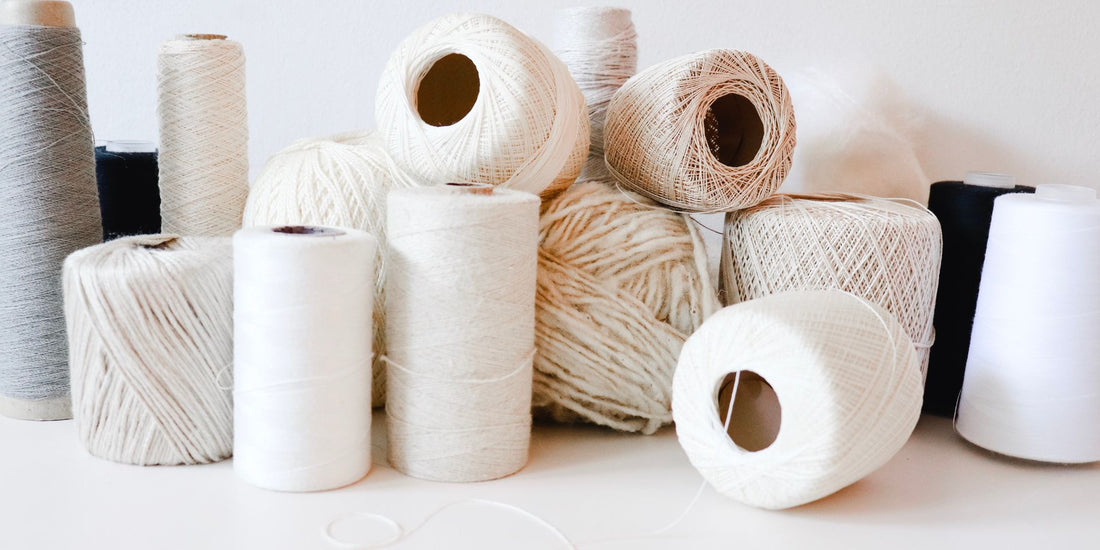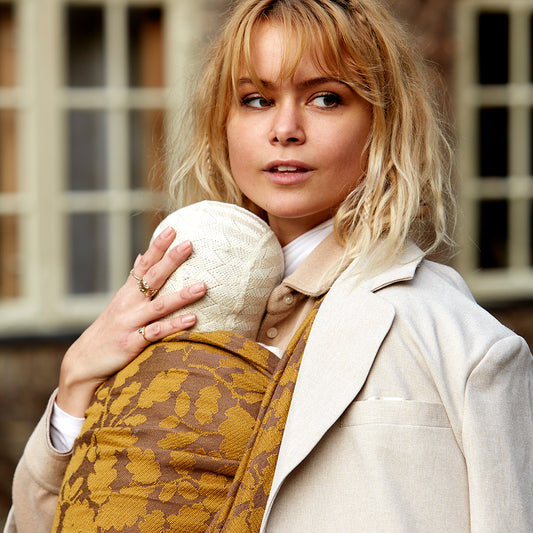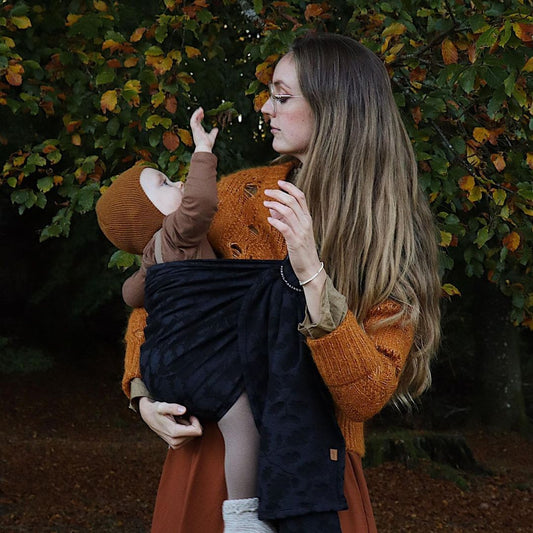The variety of fibers used to weave woven wraps and slings can seem overwhelmingly complex. What's the difference between Chenille and Pima Cotton? How is milk yarn made, and why is vicuña so unbelievably expensive?
In this article, I'll provide a brief overview and explanation of some of the materials and terms you commonly encounter. Many different terms cover variations of the same product. Once that distinction is clear, it becomes a bit easier to navigate through the extensive selection.
Note - when you click on the links below, it might jump a bit too far - scroll up a bit to get to the destination. I'm working on fixing that! /Christine
Seed fibers (e.g. cotton, kapok)
Viscose types (e.g. bamboo, SeaCell)
Thread types (e.g. chenille, bouclé)
Seed fibers
Seed fibers are fibers that are attached around a plant's seed - the seed wool. Think of dandelions' little "parachutes". Both cotton and kapok are seed fibers.
Cotton types
Cotton is spun from the seed fibers of the cotton plant and is the most common natural material used in textiles. Cotton is durable, soft against the skin, doesn't wrinkle easily, has high absorbency, and is easy to dye. It can also be washed at high temperatures.
The popularity of cotton is easy to understand, as its qualities provide several advantages over traditional materials like wool and bast fibers such as linen. Cotton is softer than linen, easier to dye, cheaper to cultivate, and simpler to process. It doesn't wrinkle, and unlike wool, it doesn't cause any itching. It can be washed at high temperatures without fear of felting.
Cotton is commonly used in woven wraps and slings, either as the sole fiber or blended with other fibers. Cotton provides a good neutral base as its characteristics aren't extreme in either direction. It's not as firm as linen or as bouncy as wool. It requires less effort to work with than linen but is still quite durable.
There's a variety of cotton. Cotton is one of the most cultivated plants globally and comes in many qualities. From stiff and almost coarse to buttery soft and luxurious.
There are several commercially cultivated cotton plant varieties. The most important to know are Gossypium barbadense and Gossypium hirsutum. G. Hirsutum is the most common type (90% of cultivated cotton) as it's more robust than the somewhat delicate but finer and longer-fibered G. barbadense (5% of cultivated cotton). The remaining 5% of cultivated cotton includes various subspecies, including Gossypium herbaceum, used for cottonseed oil.
The longer the fibers, the stronger, thinner, and smoother thread can be spun from them. When talking about "long staples" in cotton, it refers to the length of the fibers. "Long staples" are fibers between 28.6 - 33.3 mm, and "extra long staples" are 34.9 mm or longer. Based on this definition, the majority of cotton from the G. barbadense plant falls under the "extra long staples" category.
Egyptian Cotton - is, as the name suggests, cotton from Egypt. Egyptian cotton is from the cotton plant G. barbadense, and is considered some of the finest cotton in the world due to its exceptionally long fibers with a low diameter.
Pima/Supima Cotton - is also from the cotton plant G. barbadense, and was originally also called Egyptian cotton. However, Pima cotton is mainly grown in the United States. The trade name was officially changed in the 1970s to compete with cotton grown in Egypt. The difference between Egyptian cotton and Pima cotton is just that - the country of origin.
Sea Island Cotton - another trade name for cotton from the plant G. barbadense, and this trade name may only be used for cotton grown in the southeastern United States, along the coast.
Mexican cotton/Upland cotton - the most widespread type of cotton in the world, from the cotton plant G. Hirsutum. Often used for clothes and jeans.
Kapok
Kapok - comes from the kapok tree which originates from Central America. The tree is cultivated for its cottony seed fibers, and kapok is also sometimes called "Java Cotton". The kapok fibers are much shorter than cotton fibers and are difficult to spin into a thread. The fiber is very air-filled and it is therefore most often used as a filling and less often as an exotic component in thread leaves. Kapok is highly flammable but has some exceptional hydrophobic properties. In the past, kapok was used as a filling in life jackets, and the same property makes it suitable for mattress and duvet filling, as house dust mites cannot live in such low-humidity environments.
Bast fibers
Bast fibers are fibers extracted from the stem of a plant. Many of the bast fibers share properties such as firmness, cooling properties in summer and good absorbency. Often threads of bast fibers are more or less uneven, and will therefore add grip to the carrying tool.
Flax - are the fibers from the stalks of the flax plant. The flax plant is thrifty and adapted to the northern European climate. It does not require special watering or fertiliser, and is therefore one of the most climate-friendly natural fibers available, especially if you live in northern Europe, as it requires neither intensive farming nor long transport. Very little is wasted in production; the stems are used for fabric, and the seeds for linseed oil and as linseed for human consumption. The pressed linseeds from linseed oil production are used for animal feed.
Linen is extremely durable and can withstand high heat and washing with detergents containing enzymes. The fabric feels cool to the touch and is ideal for wearing in warm weather. Linen can be stiff when new, but becomes more beautiful and softer with use - how quickly this happens depends largely on the quality of the linen. In a wrap or sling, linen will contribute firmness and enormous strength in relation to the thickness of the fabric. A skein or skein of flax that has gone to will be buttery soft and floppy, and strong as an ox. One of the characteristics of linen thread is that it is often uneven but "slubs" and "nubs". Linen can tend to crease and can get perma-creases if you're unlucky; it is therefore a good idea to iron your carrying tool containing linen, so that you avoid it folding in the same place again and again.
Nettle/Ramie - grown mainly in Asia and comes from the nettle plant Boehmeria nivea, which is related to our own nettle. The fibers are extracted from the stem, and produce a fabric that does not crease easily and is cooling in hot weather. Unlike many other bast fibers, ramie requires a chemical process to clean the fiber before it can be spun. Ramie is resistant to mold and mildew. Ramie does not crease easily, but if repeatedly folded in the same place, it can break. Like hemp, it is stronger wet than dry.
Hemp - from the stems of the hemp plant. Hemp, like flax, is a very strong and cooling material, and in terms of carrying properties, they can be difficult to distinguish from each other. Hemp is stronger wet than dry, and has therefore historically been widely used in ropes for ships. In wraps, hemp typically also requires a good beating before it becomes soft and delicious.
Banana - sometimes referred to as Abaca, Manila hemp or Manila - is fiber from the leaf sheaths of the banana plant (yes, that's the technical term! It's where the leaf is attached to the stem). It can both be banana plants that are grown exclusively for their fibre, or surpluses from the production of edible bananas. There are various methods for extracting the fibres, and innovations in processing have now made it possible to utilize waste from banana production that was previously simply wasted. Depending on where the fiber is harvested from, banana pulp can vary from very coarse to very fine. Banana fiber fabric shares many of the same characteristics with the other bast fibers - it is strong, firm and absorbs moisture well. Typically the fiber will also be uneven and therefore add grip to the wrap.
Types of wool
Within the textile world, several different animal hairs are used, e.g. from sheep, alpaca, goat and rabbit. Common to all animal hair is that they are temperature-regulating and consist of the protein keratin, which can be damaged by detergents containing enzymes. All animal hair can deform when wet (sleep with wet hair and you'll know what I mean) so it's important to let a wrap with animal hair of any type dry as flat as possible so it doesn't stretch, e.g. e.g. from clamps on a clothesline.
Merino - the term for wool from sheep of the Merino breed. This breed of sheep has been bred over centuries to have wool with very long fibers and a low diameter. Merino wool is known for being very soft, with minimal wool scratching. That is why it is a favorite in underwear and baby clothes. And wraps, of course.
Read more about our merino here
See our wraps with merino wool here
Lambswool - is simply a term for wool shorn from lambs that are no older than 7 months. Wool from lambs is usually softer than wool from adult sheep, but since the term Lambswool only says something about the age of the sheep, and not about the breed the wool comes from, you cannot say much about the softness based on that term alone.
Cashmere - is wool from the cashmere goat. Only the fine underwool is used. Unlike wool from sheep, cashmere does not contain lanolin, and can therefore be a good choice if you are allergic to sheep's wool.
Alpaca - is the wool from the llama's smaller, cuter cousin, the alpaca. Alpaca wool has many of the same properties as wool from sheep, but is warmer and has less wool. Similar to cashmere, alpaca wool contains no lanolin and is therefore suitable for allergy sufferers.
Baby Alpaca - is, contrary to what one might think, not a designation that is about the animal's age. Rather, it is about the fineness of the fiber. Baby Alpaca is the finest wool from the animal - typically that which is cut from the chest.
Vicuña - you may have seen the wild prices that coils containing vicuña are sold for. It hardly gets any more exclusive. Vicuña is the extremely soft and insulating undercoat from the wild ancestor of the alpaca, the vicuña. In the 1970s, vicuñas were threatened with extinction, but total protection has fortunately increased their numbers. Vicuñas can only be shorn every 3 years, and must be captured in the wild. Each animal produces only about ½ kg of wool, which is described as the softest in the world. The fibers are extremely fine and can be easily damaged by chemical treatment; therefore vicuña wool is usually allowed to retain its natural brown colour.
Angora - spun from the hair of the Angora rabbit. The thread has a silky sheen.
Mohair - is the hair of the Angora goat (not to be confused with the Angora rabbit) Mohair is a beautiful shiny luxury fiber which, when viewed under a microscope, has a very smooth surface. It is therefore often mixed with other fibers to give the thread cohesion.
Yak - you occasionally see yak gold in coils. It is a soft luxurious fiber from the underwool of the yak, and can be compared to cashmere. However, Yakuld can have a strong smell ("wet goat") when wet.
Silk types
Silk is produced from the cocoon of the silkworm. There are countless terms for silk, but the most important distinction when it comes to assessing a silk's wearing properties is whether it is spooled or spun silk.
Both have the fantastic temperature-regulating properties of silk, and both should be washed with enzyme-free detergent. All silk, regardless of type, weakens when wet - therefore treat a wet silk wrap with care and never twist it.
Reeled silk is made from a continuous long thread, pulled from the cocoon of the silkworm. Coiled silk can only be produced by killing the moth while it is still in the pupa. Spooled silk is the completely smooth, classic shiny silk we know from wedding dresses. Spooled silk is very firm, smooth, very glossy and without bounce. Coiled silk has little or no scent.
Spun silk is shorter, broken silk threads that are spun together. Spun silk is produced from broken cocoons and from residues from the production of spun silk. Spun silk is nubby, uneven and with lots of character. Spun silk is, in contrast to spun silk, matte (possibly with a light shine), bouncy and grippy. When you are dealing with spun silk, you will often also notice the silk's distinct scent. The scent comes from the silkworm's glue, and is stronger when the silk is moist.
And that brings us to the typical labels, which often aren't much help when it comes to judging a wrap's carrying properties based on name alone. Look instead at the structure of the silk.
Mulberry silk ( Bombyx mori) - is silk from the silk moth of the species Bombyx mori, which lives exclusively on leaves from the mulberry tree. The moths have been domesticated for millennia, and they have completely lost the ability to reproduce without the help of humans. It is the most widespread type of silk. In the world of wrapping, the term "mulberry silk" is often used for spooled silk, but can also easily refer to a spun silk, such as bourette.
Tussah ( Antheraea pernyi ) - is silk from silk moths of the species Antheraea . Unlike B. Mori , which only feeds on leaves from the mulberry tree, the moths that produce tussah silk are not quite so picky. The thread is not as smooth as the thread from the mulberry silkworm. Tussah can be spooled, but often, in the world of wrapping, the term is used for the spun, knotted type of tussah silk.
Bourette - is always spun silk, and is typically made from the remains from the production of spooled silk. Bourette can be made from any type of silk, but is most often mulberry silk, as it is the most widely used.
Shappe - is the German term for bourette/silk spun from residual fibres.
Tsumugi - the Japanese term for spun silk from residual fibres.
Noil/Råsilke - another term for spun silk.
Ahimsa silk/Peace silk/Eri silk - is silk where the larva is not killed in the pupa. Ahimsa silk is often from the moth Bombyx Mori . Moths of the species Samia ricini or Antheraea pernyi are often used for the production of Eri silk. Peace silk is a collective term.
The caterpillars are reared in the traditional way, but instead of being killed as soon as the cocoon is spun, the caterpillar is allowed to complete the metamorphosis in 10 days into a moth. This extends the production time considerably, and this type of silk is also typically very expensive. The broken cocoons are cleaned and the silk is spun. It is therefore always about spun silk, with the properties that spun silk has.
A detail that is often easily and elegantly skipped over when talking about peace silk is what happens to all the many thousands of moths that are the result of the production.
Viscose types
Viscose (Rayon/Lyocell/Modal)
Have you ever come across a wrap with coffee? Paper? Rose? Bamboo? Ingenuity knows no bounds, but behind the funny names the secret is something more unsexy - in all cases it is a question of types of viscose, and the wearing characteristics are pretty much the same.
Viscose is a semi-synthetic fiber that is produced by chemically breaking down plant-based material so that a thread can be spun from the liquid cellulose. There are variations on the process that have their own names, such as Lyocell and Modal. Regardless of the manufacturing method, the result of the process is a soft, slightly shiny fabric that, like natural plant fibers, can be washed with normal, enzyme-containing detergent.
The viscose process produces a textile that has the following wearing characteristics: It is very soft, smooth with a slight sheen and a little bounce. It is naturally antibacterial, drapes beautifully, is moisture absorbent and cool to the touch.
Viscose is less strong than cotton, and can become deformed when twisted when wet. Wraps in blends with a high proportion of viscose are therefore often only recommended for smaller children.
Most known in the wrapping world is bamboo viscose , and most other types of viscose will have similar properties.
When viscose is referred to by other names such as rose, coffee etc., it is not because the cellulose is exclusively extracted from roses or coffee. Often, the majority consists of wood pulp, and the named ingredients make up only a small % of the raw material.
Lyocell - is a new, more climate-friendly way of producing viscose. It is therefore the term for a method, rather than the raw material, which is typically wood pulp.
Modal - is a type of viscose produced by a patented process that makes it more durable. Again, it is a method, rather than a specific ingredient. Often, however, modal is made of beech wood.
Bamboo - viscose made from/with bamboo. In Europe, bamboo viscose is often referred to simply as "bamboo" - in the US it is forbidden to market bamboo viscose in this way. Here it is required to be labeled as "Rayon" (American term for viscose) or "Rayon from Bamboo".
Seacell ™ - a registered trademark. This is lyocell made with cellulose extracted from seaweed. The seaweed part makes up about 5%, the rest is cellulose from wood pulp.
Seaweed - is viscose or lyocell made with a proportion of seaweed. Unlike Seacell, Seaweed is not a trademarked name.
Pearl - viscose/lyocell, where powdered pearls have been added in the part of the process where the cellulose is liquid.
Rose/Peppermint/Coffee/Paper/Eucalyptus - in the same style as Seacell, this is a viscose, where a smaller percentage of the cellulose comes from rose/peppermint/coffee etc.
Plant-based and you've never heard of it before? But they say it's soft and shiny, maybe it falls very nicely and is cool to the touch? ("silky shine")? Probably viscose with less % of the ingredient mentioned 😜
Other fibers
Milk/Azlon - milk yarn sounds crazy, but it's good enough. Milk fiber is a semi-synthetic fiber that is extracted after the raw material - milk - has been chemically broken down. The fiber from milk consists of the protein casein. Milk fiber yarn is heavy, very soft, shiny and sweat-wicking. Like other protein fibers (wool, silk), milk fiber cannot withstand being washed with enzyme-containing detergents.
Thread types
Chenille - is not a type of cotton, but rather a way of spinning a thread. However, cotton is often used. A chenille thread looks and feels a bit like a furry caterpillar. The chenille thread consists of two long threads that are twisted around a lot of very short, cut threads, so that the result is a soft furry thread. Chenille yarn is therefore very grippy in a wrap, but can "shed" the short fibers if it is treated incorrectly (tumble dried, for example).
Bouclé - this is not a fiber type either, but again a way of spinning a thread. With a bouclé thread, two threads are spun together, but with unequal tension. This results in a lot of small loops on the finished thread, which gives a woolly effect in the surface of the fabric. In a wrap or loop, a bouclé yarn will provide plenty of grip. However, you have to be careful that the many small loops can catch on earrings etc. Bouclé can be made with all types of fibres.










